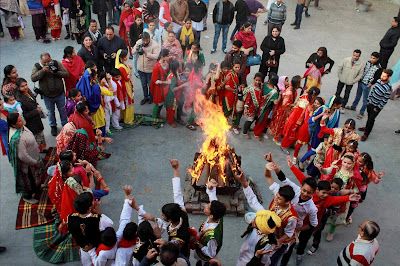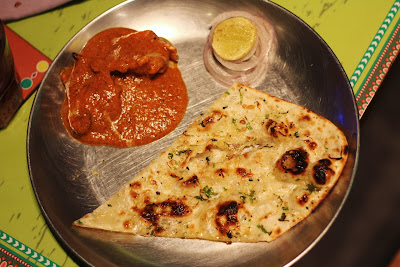Balle, Balle!!! Lohri is here!
Lohri is a harvest festival, celebrated on 13 January in Northern-India (especially Punjab). Communities gather around the bonfire in the night and offer revadi (sesame brittles), popcorn and peanuts to it.
Significance of Lohri
• Celebrating the winter crop season
• Paying obeisance to the Sun and the Agni (Fire Deity)
• Offering a tribute to Dulha Bhatti, who rescued girls from being forcibly sold in the Middle East Slave Market during the Mughal Dynasty Rule. With Sundri and Mundri being two Punjabi girls whom he saved and around whom all Lohri songs are interwoven.
Just like Christmas, during Lohri too children go from house-to-house singing the traditional folk songs and the householders appreciate them by giving them snacks, sweets and money.
Food centric to Lohri celebrations like – gajak (chikki); sarson-da-saag (mustard vegetable); makke-di-roti (maize chapattis) etc. – is made from winter harvest items like – sugarcane; nuts; radish; mustard greens; maize; groundnuts; etc.
Traditional Lohri Dish
Tricholi or “Til rice" is a popular Lohri dish made by mixing jaggery, sesame seeds and rice.
Lohri Ki Thaali (Lohri Meal)
No plate is complete for a Punjabi on Lohri without – Sarson-da-saag (mustard vegetable rich in folate, iron and varied nutrients); Makke-di-roti made from maize flour, ghee, salt, fenugreek leaves and red chilli powder; Atta Ladoo comprising of flour, jaggery and ghee; and Dahi Bhalle, a healthy side-dish prepared from curd, tamarind sauce, dry fruits, urad dal (black gram), coriander leaves, green chillies and spices
Let’s dance, sing songs, eat Lohri Ki Thaali and exchange gifts to ring in spring!
Significance of Lohri
• Celebrating the winter crop season
• Paying obeisance to the Sun and the Agni (Fire Deity)
• Offering a tribute to Dulha Bhatti, who rescued girls from being forcibly sold in the Middle East Slave Market during the Mughal Dynasty Rule. With Sundri and Mundri being two Punjabi girls whom he saved and around whom all Lohri songs are interwoven.
Just like Christmas, during Lohri too children go from house-to-house singing the traditional folk songs and the householders appreciate them by giving them snacks, sweets and money.
Food centric to Lohri celebrations like – gajak (chikki); sarson-da-saag (mustard vegetable); makke-di-roti (maize chapattis) etc. – is made from winter harvest items like – sugarcane; nuts; radish; mustard greens; maize; groundnuts; etc.
Traditional Lohri Dish
Tricholi or “Til rice" is a popular Lohri dish made by mixing jaggery, sesame seeds and rice.
Lohri Ki Thaali (Lohri Meal)
No plate is complete for a Punjabi on Lohri without – Sarson-da-saag (mustard vegetable rich in folate, iron and varied nutrients); Makke-di-roti made from maize flour, ghee, salt, fenugreek leaves and red chilli powder; Atta Ladoo comprising of flour, jaggery and ghee; and Dahi Bhalle, a healthy side-dish prepared from curd, tamarind sauce, dry fruits, urad dal (black gram), coriander leaves, green chillies and spices
Let’s dance, sing songs, eat Lohri Ki Thaali and exchange gifts to ring in spring!



Comments
Post a Comment